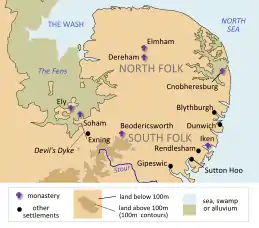520
Year 520 (DXX) was a leap year starting on Wednesday (link will display the full calendar) of the Julian calendar. In the Roman Empire, it was known as the Year of the Consulship of Rusticus and Vitalianus (or, less frequently, year 1273 Ab urbe condita). The denomination 520 for this year has been used since the early medieval period, when the Anno Domini calendar era became the prevalent method in Europe for naming years.
| Millennium: | 1st millennium |
|---|---|
| Centuries: | |
| Decades: | |
| Years: |
| 520 by topic |
|---|
| Leaders |
|
| Categories |
|
| Gregorian calendar | 520 DXX |
| Ab urbe condita | 1273 |
| Assyrian calendar | 5270 |
| Balinese saka calendar | 441–442 |
| Bengali calendar | −73 |
| Berber calendar | 1470 |
| Buddhist calendar | 1064 |
| Burmese calendar | −118 |
| Byzantine calendar | 6028–6029 |
| Chinese calendar | 己亥年 (Earth Pig) 3216 or 3156 — to — 庚子年 (Metal Rat) 3217 or 3157 |
| Coptic calendar | 236–237 |
| Discordian calendar | 1686 |
| Ethiopian calendar | 512–513 |
| Hebrew calendar | 4280–4281 |
| Hindu calendars | |
| - Vikram Samvat | 576–577 |
| - Shaka Samvat | 441–442 |
| - Kali Yuga | 3620–3621 |
| Holocene calendar | 10520 |
| Iranian calendar | 102 BP – 101 BP |
| Islamic calendar | 105 BH – 104 BH |
| Javanese calendar | 407–408 |
| Julian calendar | 520 DXX |
| Korean calendar | 2853 |
| Minguo calendar | 1392 before ROC 民前1392年 |
| Nanakshahi calendar | −948 |
| Seleucid era | 831/832 AG |
| Thai solar calendar | 1062–1063 |
| Tibetan calendar | 阴土猪年 (female Earth-Pig) 646 or 265 or −507 — to — 阳金鼠年 (male Iron-Rat) 647 or 266 or −506 |

The Kingdom of East Anglia (6th century)
Events
Byzantine Empire
- Priscian, Latin grammarian, writes the Institutiones Grammaticae ("Grammatical Foundations"). In Constantinople, he codifies this manuscript in 18 volumes, that will be widely used through the Middle Ages. It provides the raw material for the field of speculative grammar.
- July – Byzantine general Vitalian becomes consul, and is shortly later murdered, probably on the orders of Justinian, the nephew and heir-apparent of Emperor Justin I.
Britannia
- King Pabo Post Prydain of the Pennines (Northern England) abdicates his throne, and divides the kingdom between his two sons. He retires, as a hermit, to Anglesey.
- The Kingdom of East Anglia is formed, by the merging of the English counties of Norfolk and Suffolk, and perhaps the eastern part of The Fens (approximate date).
- King Budic II returns to Cornouaille (Brittany), to claim the Breton throne (approximate date).
Europe
- Ostrogothic ruler Theodoric the Great builds the Mausoleum of Theodoric, as his future tomb in Ravenna (Italy).
Asia
- Bodhidharma, Buddhist monk, arrives in Luoyang. He spreads Buddhism and travels to the northern Chinese kingdom of Wei, to the Shaolin Monastery.
Religion
- February 25 – Epiphanius is elected patriarch of Constantinople by Byzantine Emperor Justin I.
- The construction of the Basilica of San Vitale in Ravenna, is started (approximate date).
Births
- Hou Andu, general of the Chen Dynasty (d. 563)
- Justin II, emperor of the Byzantine Empire (d. 578)
- Malo, Welsh bishop (approximate date)
- Martin of Braga, missionary and archbishop (d. 580)
- Pope Pelagius II of Rome (d. 589)
- Radegund, Frankish princess (approx.)
- Zuhayr bin Abi Sulma, Arabian poet (approx.)
Deaths
- January 19 – John of Cappadocia, patriarch of Constantinople
- July – Vitalian, Byzantine general, consul
- Abbán, Irish cult leader and saint (approx.)
- Ardgal mac Conaill, king of Uisneach (Ireland)
- Isidore of Alexandria, Neoplatonist philosopher (approximate date)
- Maximinus, Frankish abbot and saint (approximate date)
- Zu Gengzhi, Chinese mathematician (approx.)
References
This article is issued from Wikipedia. The text is licensed under Creative Commons - Attribution - Sharealike. Additional terms may apply for the media files.